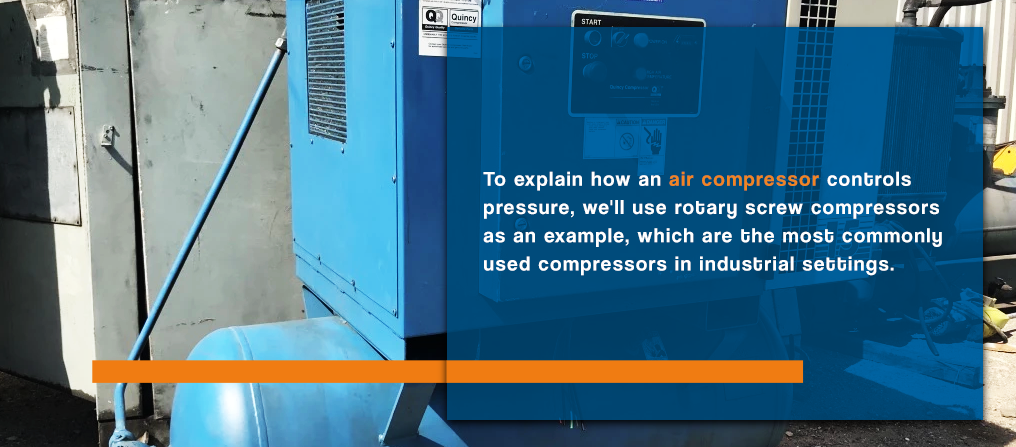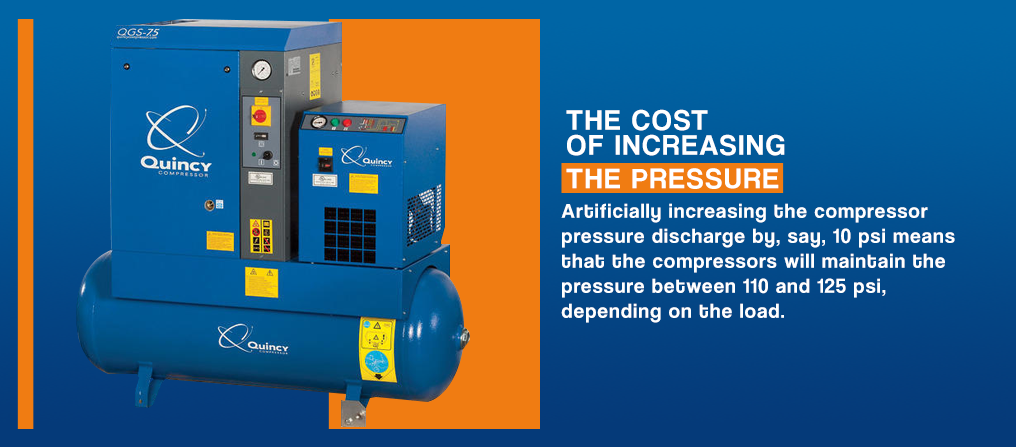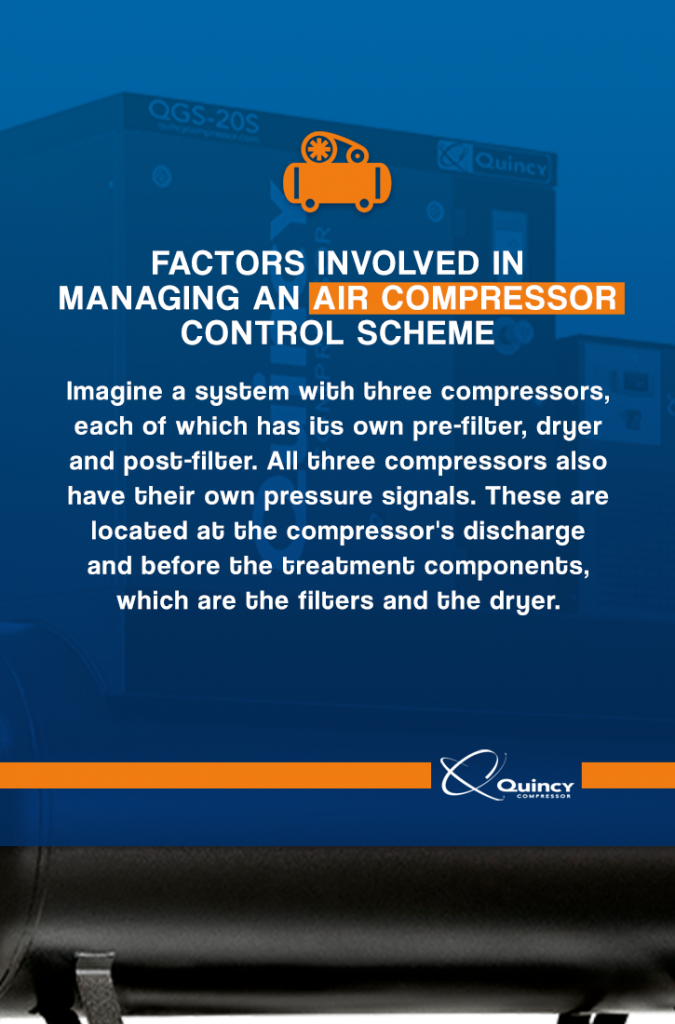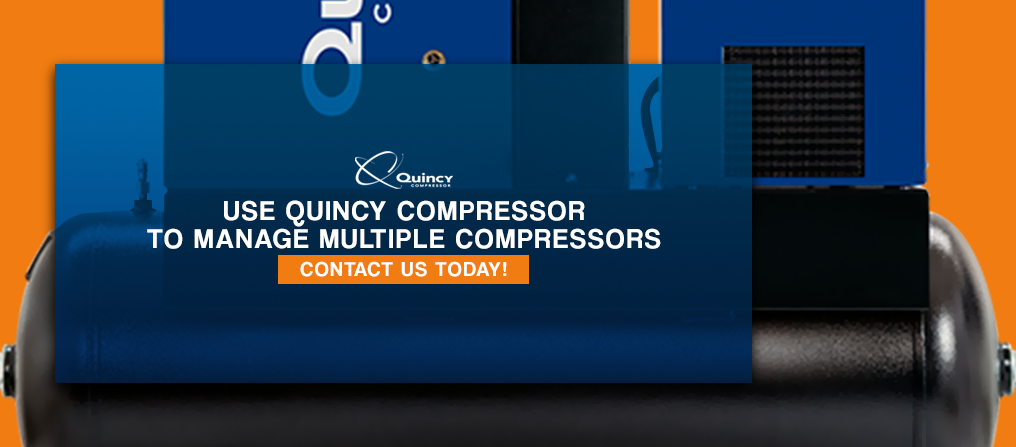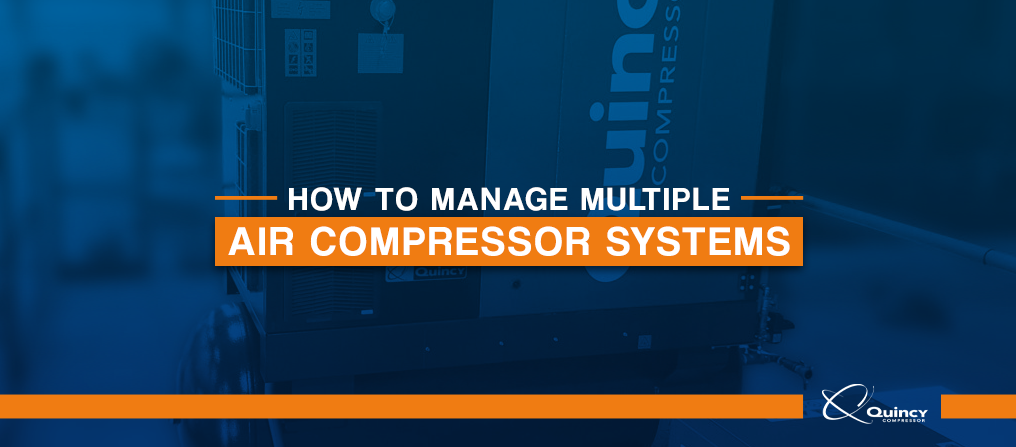
Controlling compressed air systems can be challenging, especially if you’re using multiple air compressors in different rooms. If you’re controlling your system manually and following a procedure using local pressure settings, you’re likely wasting a lot of energy. However, if you learn how to properly manage multiple compressed air systems, you can lower your energy costs significantly and achieve more reliable air pressure.
Understanding Compressor Control Pressure
To explain how an air compressor controls pressure, we’ll use rotary screw compressors as an example, which are the most commonly used compressors in industrial settings. The strategies we discuss below may not necessarily be applicable to centrifugal compressor systems.
In compressed air systems, the single most critical parameter is pressure. If the pressure is not kept above a certain minimum level, the machines powered by the compressed air will no longer function properly, which may disrupt production. If the world were perfect, controlling the pressure would be simple. We could easily set compressors to the minimum required air pressure. Without any help from us, the compressors could start, stop, load and unload to maintain the ideal pressure output and optimal energy consumption.
However, it’s not that straightforward, as there is a big issue you’ll have to deal with — the pressure differential. To illustrate this problem, consider a simple compressed air system in which the air leaving two compressors passes through a filter, a dryer, system piping and then a filter, regulator and lubricator (FRL) before arriving at the critical end-user.
The compressors control the pressure of the air leaving the system. In a normal cascaded pressure band arrangement, these machines would generally provide an air pressure of around 100 pounds per square inch (psi) when both compressors are fully loaded. This would change to about 115 psi when the loads are lightest.
However, as the air moves through each system component, it loses pressure. This means that by the time it reaches the end-user, the pressure is significantly lower. The pressure here — where the critical end-user is — needs to be accurately controlled. Real-world conditions make it difficult to manage this pressure with precision, though.
How Drops in Air Pressure Affect the System
When the air compressors are fully loaded, the air pressure experiences a drop when moving across system components. Below is an example of common pressure drops that occur when air passes through the system:
- 4 psi drop in the filter.
- 6 psi drop in the dryer.
- 5 psi drop in the piping.
- 15 psi drop in the FRL.
In this example, the air experienced a total drop of 30 psi on its journey from the compressor to the critical end-user. This issue means that, if the air leaving the compressor was 100 psi, the end-user will only have 70 psi to work with. This is the worst-case scenario when the system is fully loaded.
Can the air pressure delivered to the end-user be stabilized with the help of the compressor control? The answer to that is no. The compressor can only control the pressure of the air leaving the machine itself, but not once it has passed through other system components.
If the end-use applications of this air include pressure-sensitive tasks, this large pressure variation can cause a wide range of problems. Among others, it could lead to inconsistent output or even bring the operation to a halt completely. To deal with this pressure inconsistency at the end-user, operators will often increase the compressor’s discharge pressure artificially to compensate for lower pressure.
The Cost of Increasing the Pressure
Artificially increasing the compressor pressure discharge by, say, 10 psi means that the compressors will maintain the pressure between 110 and 125 psi, depending on the load. The higher pressure, however, will come at a cost. It is a general rule that, at roughly 100 psi, for every 2 psi increase in the discharge pressure, the compressor’s power consumption increases by approximately 1%.
Increasing the discharge pressure could also lead to other negative consequences. An air compressor’s typical maximum pressure rating is 125 psi, and if this rating is exceeded, it may overload the motor.
Multiple Compressor Locations
In the case of a system running multiple air compressors, you will encounter even more problems, especially if the compressors are in different rooms. This phenomenon happens because each compressor will likely experience different loads and air pressure differentials.
For a dual air compressor setup to be controlled efficiently, the compressors in each of these rooms need to be coordinated properly. A wide pressure band is necessary to achieve this using local compressor setpoint adjustment.
However, if the loads vary widely, coordinating multiple compressors is virtually impossible. The only exception would be if the compressors could somehow share loads with all units operating at partial loads.
Inefficiencies of Part Loading
One misguided approach would be to set all compressors to exactly the same pressure so they can share the load. With this strategy, the machines will maintain the system’s pressure within the same acceptable band, allowing them to share the load.
However, while this seems like a simple solution, the energy penalty is huge. This is because fixed-speed rotary screw compressors tend to attain optimal efficiency when the load is full.
For example, if you run your compressor at a 30% load, it may consume anywhere between 60% and 80% of what it would at full load. If you run three compressors at a 30% load, they might consume two times what a single compressor would use at full load. Now imagine how much energy this would expend if you did the same with 10 compressors! Your energy bills would be incredibly high.
No matter what system you use, the best strategy is to keep all of your compressors fully loaded except for one. The one that takes the partial load should also have the highest partial load efficiency.
Eliminate Pressure Differentials
Even if you attempt to control the pressure farther down the line, such as between the dryer and the piping or between the piping and the FRL, you still won’t be able to eliminate the pressure differential issues that could arise at the critical end-user.
Keep in mind that plants often have several hundred critical users, and controlling the air pressure for all of them is simply impossible. What is possible, however, is designing high-quality, reliable components that feed the end-user.
One reason many compressor systems experience such undesirable pressure differentials is that they don’t use optimized components. Many parts are chosen simply because they fit the standard available sizes used in the plant — not necessarily because they’re the best components for the application. This issue applies to system elements such as:
- Regulators
- Hoses
- Connectors
- Filters
These components are not always installed properly, either. During installation, little regard is often given to the peak demands of the parts connected at the hose’s far end. For instance, if a big air-powered impact wrench is connected to a long quarter-inch hose, the resulting pressure differentials could be extreme. The components’ sizes should receive upgrades to suit the peak tool requirement, which will decrease the pressure differential dramatically.
You can reduce the pressure differential at every component by upgrading that element accordingly. If you can upgrade the filter styles, upsize the air dryers and increase the piping’s capacity, you can then decrease the pressure differential and be better able to deliver the required air pressure to the end-user. You can achieve both of these things without having to raise the discharge pressure and waste energy.
Utilizing Controls to Improve Performance Efficiency
If you’re using an unmanaged strategy for controlling multiple air compressors, you will experience unnecessary power consumption and more frequent or unexpected maintenance issues. If you manage your compressors using just the onboard controllers, this technique could cause problems like:
- Overconsumption: More compressors are running than are needed, which lowers your plant’s energy efficiency.
- Inefficient operations: The combination of air compressors running is not optimal, which slows your productivity and increases your power consumption.
- High pressure: Your air compressors’ pressure is unnecessarily high.
Why do these things happen? By looking at signals, setpoints and differentials, you can begin to understand how complex a system run using only onboard controllers is.
Factors Involved in Managing an Air Compressor Control Scheme
Imagine a system with three compressors, each of which has its own pre-filter, dryer and post-filter. All three compressors also have their own pressure signals. These are located at the compressor’s discharge and before the treatment components, which are the filters and the dryer. To make sure that all compressors are aligned, the pressure transducers would have to be calibrated perfectly with one another.
Another factor that influences this control scheme is how much of a pressure drop there is from where the compressors discharge the air to the receiver tank, which is downstream from the air treatment components. Unless the air treatment components and piping cause the exact same drop in pressure, your compressors won’t be aligned.
Perfect alignment is rarely the case due to various factors, including maintenance intervals and the air treatment equipment’s differing characteristics. When signals and differentials are mismatched, this will cause too many air compressors to run, which wastes energy and needlessly increases maintenance intervals.
Yet another factor that influences how you control your compressors is the compressor control’s setpoints. If you have fixed-speed compressors, they are controlled using inlet valves, typically in a “load/unload” mode, which means the valve is either completely open or closed. Usually, the difference between the load and unload points is 10 psi.
If the motor speed controls your compressor, “setpoints” become “target pressure.” If you have more than one compressor in local control, your setpoints spread over a broad range, which causes your first compressor to run at a higher pressure to maintain this control scheme.
This strategy, known as a cascade control scheme, increases a system’s power consumption resulting from the elevated pressure. In a typical cascade control scheme, the compressor that starts last is set to the minimum acceptable pressure. Conversely, the compressor that starts first and turns off last is set to start at 115 psi and shut off at 125 psi.
In situations where demand is low, the compressor system can run between 25 and 35 psi over the minimum acceptable pressure. This would consume roughly 15% more power than what would normally be needed for that demand.
Benefits of Remote Connectivity
No matter what type of air compressors you have, you can apply and link high-quality system controls to monitor and control your compressor systems. Manufacturers often develop and provide their own equipment for monitoring, which includes a graphical interface so you can visualize what’s going on in your system. Remote web-based controls are also generally available with these setups.
There are many benefits of utilizing remote communication. For instance, consider this scenario. A compressor with no remote connectivity capabilities to send an alert or sound an alarm breaks down during a low-production shift when no experienced maintenance staff is around. The plant personnel subsequently have to deal with this interruption in their air supply. Further, they will likely have to halt production while they contact an emergency service provider and wait for them to arrive.
Consider the same situation as before, but with a mobile alert notification built into the control system that immediately notifies the service provider. This feature allows the provider to quickly and remotely assess what’s going on. They can review the system’s operating parameters and figure out how the shutdown occurred. This notification system can even let the provider restart the air compressor if they offer permission for this action.
Ultimately, remote connectivity dramatically improves the quality and speed of the response, which improves productivity, saves time and increases the bottom line.
Use Quincy Compressor to Manage Multiple Compressors
We realize how important it is for you to keep your business up and running while simultaneously protecting your employees’ well-being and encouraging their productivity. For this reason, we offer you solutions that allow you to monitor your equipment remotely for easier maintenance and operational capabilities.
With ICONS, we can monitor your air compressor setup for you. This technology allows us to check your machinery’s condition so your production can continue without any interruptions. You receive complete insight into your business’s compressed air production and management without the need for extensive logbooks or multiple trips to your compressor rooms. If an issue with your equipment arises, you can rest assured that we will contact you right away and discuss how we can resolve the problem before your business experiences any disruptions.
Historically, when compressors went down, there was no warning. Technicians rushed in to fix the issue, which led to downtime and loss of production as companies were not prepared for scheduling around maintenance. With ICONS, we can fix problems before they have a chance to interrupt your production. If you’re interested in taking advantage of this business solution, contact our knowledgeable air experts at Quincy Compressor for more information on how we can help you begin.


